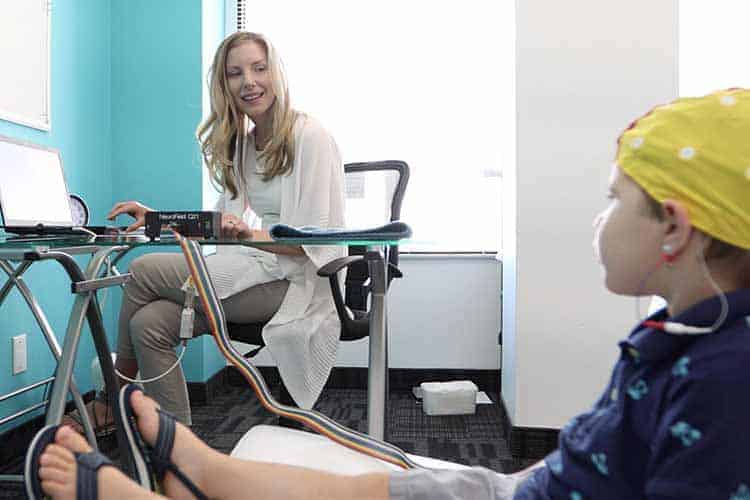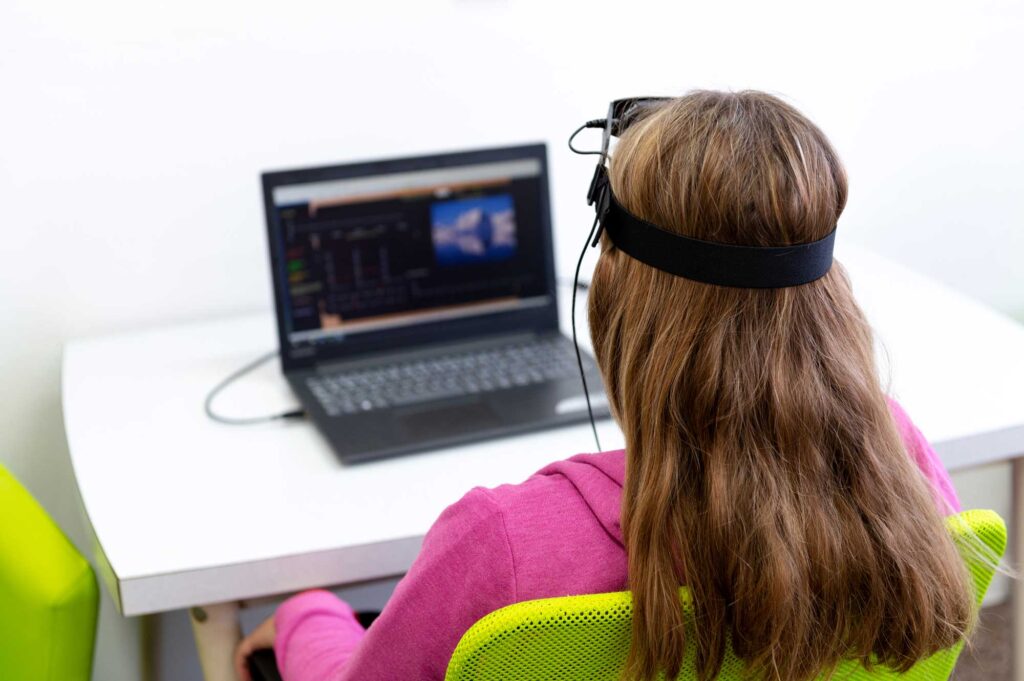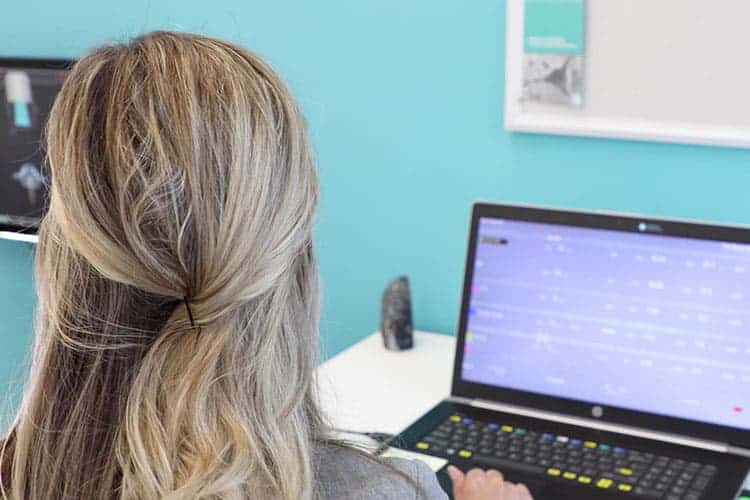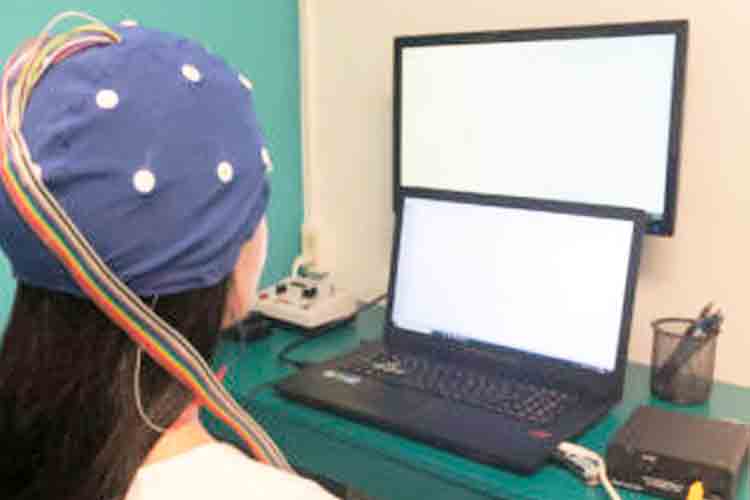Through this form of EEG biofeedback, your brain can heal the root causes linked to your symptoms. Customized treatment can offer long lasting positive changes.
Even without a diagnosis for a specific condition, neurofeedback can help relieve the symptoms of ADHD, anxiety, depression, PTSD and learning disabilities.
If you’re interested in seeing if Neurofeedback can be helpful, book a call to learn more.
A detailed interview where we discuss your symptoms, your current health, and goals for treatment. This is also an opportunity to ask us any questions about Neurofeedback treatment.
A baseline recording of your brainwave function is recorded and analyzed to understand your symptoms further and create your customized treatment plan.
Customized Treatment sessions are 30-60 minutes, one to three times a week. No surgery, no medication.
When you contact us, you will be booked for a 50-minute intake with one of our specially trained clinicians. This appointment is your opportunity to let our team know what you have been experiencing and better understand your treatment goals.
We will spend this time getting to know you, gather information about your symptoms/experiences, history, and indicators of brain arousal patterns.
This information will allow us to give you feedback about whether you are a good candidate for Psychotherapy, Neurofeedback or if any further assessments may be beneficial. This is also your opportunity to ask questions and understand how these treatment options can help you move forward.
After this session, we will guide you to the next step in the Neurofeedback process and/or offer Psychotherapy options.
The intake fee is covered under most insurance plans.


A Quantitative Electroenecephalograph (QEEG) is an extensive analysis of an individual’s brain activity. The QEEG is the gold standard of Neurofeedback assessments used to understand brain function, arousal patterns and neural pathways. This process involves two appointments. In the first appointment (QEEG Acquisition), you will come into the office for one hour so we can place a cap with sensors on your head to create a visual map of your brain activity called a QEEG.
We will ask you to sit still during the process so we can take an eyes open and eyes closed recording of your brain activity. Once the recordings are complete, we will remove the cap and you can leave the office.
After this session, we analyze your QEEG for any activity that could be related to your symptoms (e.g., excess high beta activity that may relate to anxiety), compare your brain functioning to a ‘normative’ database, examine connectivity/neural pathways (e.g., important for concussions, learning disorders and autism spectrum disorder) and EEG morphology.
All of this information is used to help us understand the underlying brain function that could be contributing to your identified symptoms. Taking all of this information with the history you provided us during your intake consultation, we will collaboratively form a treatment plan with you during the feedback session. It is in this second appointment (QEEG Feedback) that we will review the data together. At this feedback appointment you will be provided with a summary and images of your brain activity.
The cost to complete the QEEG Brain Map assessment covered under most insurance plans.
We offer multiple types of Neurofeedback treatments, including Traditional Neurofeedback (Single-Channel Training), LoRETA Z-Score Training, High Performance Neurofeedback (HPN), Neuroptimal Neurofeedback and Audio-Visual Entrainment. Each of these treatments have slight variations in how they work to allow your brain to make changes. The number of sessions and the length of the sessions will be customized to your individual needs. A typical course of treatment may be attending the office twice per week for 3-4 months followed by once per week for an addition 1-2 months.
When tracking progress, some types of neurofeedback treatments will rely on weekly monitored data, while other types will rely on symptom reports. For LoRETA Z-Score Training, after 12 sessions you will receive a complimentary review session with one of our clinicians to discuss your progress and determine if changes to treatment need to be made. For Traditional Neurofeedback (Single-Channel Training) this review happens at around 20 sessions and may be a part of your sessions or booked separately with a clinician.
Treatment sessions can range in price with the average cost being $100 per session.
Covered under most insurance plans.

In Traditional Neurofeedback (also known as single-channel training), we place sensors on two sites of your head and during the session you play a video game with your brain. This system is based on the theory of operant conditioning where the client is rewarded with beeps, points, and game play when they change their brainwaves to healthier patterns.
It is recommended to do a QEEG Brain Map before beginning this type of Neurofeedback. The brain map allows us to see the precise parts of the brain that are dysregulated, which helps with ensuring the sensors are placed on the correct sites of the brain that need feedback.
Traditional Neurofeedback is the most well-researched and The American Academy of Pediatrics (AAP) recently rated this type of Neurofeedback at the same level of efficacy as stimulant medication for use with those dealing with ADD and ADD/ADHD. It is stabilizing for anyone who has imbalances in the QEEG.

![hqdefault[1]](https://truenorthpsychological.com/wp-content/uploads/hqdefault1.jpg)


LoReta Z-Score Training (also referred to as LoReta Neurofeedback) is the most advanced form of Neurofeedback training. It helps regulate the deep structures of the brain and improve connectivity between the brain networks unlike any other type of Neurofeedback.
The goal of LoReta is to reinforce stability of information processing in dysregulated networks and connections based on the client’s symptoms. It targets the specific areas of the brain and connections between nodes that are linked to the symptoms. In doing so it specifically targets deep brain structures that are out of balance. Similar to traditional Neurofeedback (single channel Neurofeedback) training it provides operant conditioning (rewards) based on your brainwaves compared to the brainwaves of a healthy population. One of the benefits of LoReta is that it can target many networks of the brain and symptoms at the exact same time. For this reason, clients often require fewer sessions than traditional Neurofeedback.
In each session, a cap with 19 sensors is applied to your head. During training, your brainwaves learn to become balanced and normalized as they are rewarded.
High Performance Neurofeedback (HPN) which is sometimes referred to as NeuroGen neurofeedback; gently pushes the brain out of stuck patterns. As your sessions progress your neurotherapist will move the sensors gradually across 10 different sites of the brain providing feedback to the whole brain. The sensors pick up on the dominant stuck patterns in the brain and then the system sends a slightly different frequency back to the brain. But don’t worry, you don’t feel a thing! Though the brain is receiving a signal, the signal going back to the brain is about 4,000 times weaker than what your brain is exposed to when you hold a cell phone to your head. The brain is basically given, for a few seconds, something new to do. The brain is a copycat so it follows the lead of the frequency that it is sent and copies it for a few seconds. This gently nudges the brain out of its dysfunctional stuck pattern (such as racing thoughts due to fast firing neurons, or inattention, depression, poor motivation and concentration or brain fog due to excess slow wave activity in the brain).
No effort is required on the client’s part and results can be felt quickly! Some people even feel the results before the session ends. Most people will feel a difference within their first four sessions. HPN is used for children as young as two-years old and is great for kids who have trouble sitting still as the sensors are placed on different sites of the head for only a few seconds at a time. HPN is a very global treatment, targeting many symptoms and imbalances at the same time.


Audio-Visual Entrainment is a simple, non-invasive device that uses a coordinated series of light and sound at specific frequencies to gently and safely guide your brain into the desired patterns. The frequencies and patterns produced can aid in meditative practices, calming the mind, boosting mood, improving sleep and/or helping with mental clarity.
AVE is a drug-free approach to some conditions such as Anxiety, Seasonal Affective Disorder, Chronic pain, Fibromyalgia, PTSD and ADHD. It has also shown to heighten performance and improve cognition. It is a proven way of exercising the brain as these pattern changes can be quantified using QEEGs or brain mapping. Research has also shown stimulation of frontal regions of the brain increases synaptic density. The use of the AVE can help the brain recover, repair and restore its equilibrium.
We are proud to introduce Audio-Visual Entrainment as an adjunct to your regular neurofeedback treatment and/or psychotherapy sessions. You can speak with your therapist and decide together what type of protocol you want to try and we will develop a treatment plan with you.
In Nova Scotia you can reach the Mental Health Mobile Crisis Team at 1-888-429-8167 (Toll Free).
In New Brunswick call Chimo Helpline at
1-800-667-5005
In Ontario call Connex Ontario Health Services Information at 1 866-531-2600
General Connex call Ontario Helpline at 1-866-531-2600
The Canada Suicide Prevention Service is available 24/7, 365 days a year. You can reach them by calling
1-833-456-4566.
Copyright ©2025 • True North Psychological Services